The southern city of Shenzhen aspires to become China’s SiliconValley. But while it boasts some well-known technology companies,perhaps its strongest resemblance to the U.S. tech hubis something less enviable: sky-high housing prices.
Shenzhen topped Beijing and Shanghai to become China’s mostexpensive housing market in May 2015, according to E-house China R&D Institute, a real-estate research organization. Through April, housing prices in Shenzhen hadrisen 62% from a year earlier, compared with 28% in Beijing, anothertech center, according to Lianjia Real Estate Agency, a top brokerage firm in China.
On average, homes in Shenzhen sold at 49,259 yuan per squaremeter, or roughly $690 a square foot, in April, according to Lianjia.That’s nearly as much as the Rockridge neighborhood in Oakland,Calif., a pricey part of the San Francisco Bay Area, wherehome prices averaged $704 a square foot in April, according toEstately, a Seattle-based homebuying site—even thoughaverage incomelevels in Shenzhen are about one-tenth of those in theSilicon Valley.
In China’s tech industry, runaway hype can be destructive. With Shenzhen, the rapid rise in housing prices threatens to undermine thevery goal that fueled the surge: the dream oftransitioning from a manufacturing center to a city with “innovation as its main growth engine,” as the Shenzhen government put it in its annual work report this year. The lack of affordable housing is causing talent and companies to leave or consider leaving for more affordable cities. Executives have to scramble to find ways to retain staff and reduce turnover.
Ren Zhenfei,founder of Huawei Technologies, one of the biggest Shenzhen-based companies, recently lamented the effects of the city’shousing prices. He warned in an interview last month with the state-run Xinhua News Agency that high costs could destroy the city’s competitiveness during an age when capital and jobs can move with ease. “People need housing and living facilities,” he was quoted as saying. “When living facilities become too expensive, companies can’t bear it.”
Shenzhen’s prices are soaring for several reasons. It is a small city by area relative to China’s biggest metropolises, at about one-eighththe size of Beijing and one-third of Shanghai, so there is limited landto build out. It also is near Hong Kong, among the most expensive housing markets in the world.
But it also is an example of the speculative fever that has driven much of China’s property market over the years, especially wheneverthere is a so-called concept that can justify price increases. The concept of China’s Silicon Valley provides a lot of room for imagination.
The originalSilicon Valley is having its own difficultieswith high property prices. Tech executives in Shenzhen worry that the ill effects in the Chinese city could be more significant because the spike in housing prices ishurting its competitiveness before Shenzhen has had time todevelop into a full-fledged tech hub.
While Silicon Valley’s housing prices are supported by a concentration of top talent and the biggest tech companies in the world, Shenzhen isstill on its way, saysBill Liu,who founded flexible-display startupRoyolein Silicon Valley and Shenzhen simultaneously in 2012.
Cities need to have housing prices that are in proportion with salaries, he says. “It will be beneficial to both the city’ssustainable growth and companies’ global competitiveness.”
WhenWu Kailong,a co-founder of Smartind Technologies, asked some factory owners to use his company’s technology for automation and dataexchanges, they in turn asked, “Why bother?” Mr. Wu said they told him thatthey would rather invest in apartments than factory upgrades because if they had sold their factories earlier and invested in real estate,they would have made a lot more money.
To cool the market, Shenzhen’s government has issued stricter rules for people to qualify as buyers, and housing prices fell 0.4% inApril from March, after an 18-month rally. The government also setaside subsidized housing for rent for qualified talents.
But people in the tech industry say that the supply is limited and doesn’t solve long-term problems. An official with the Shenzhen government’s foreign-affairs office referred questions to the city’s propaganda office and science and innovation commission, where calls went unanswered.
The phenomenon is pushing up costs for startups.Aaron Zhang,founder of drone maker Shenzhen Simtoo Intelligent Technology, provides500 yuan a month to low-salary employeesbecause rents can take as much as half of their monthly pay, which stands around $1,000. He says even his top engineers, who earn over 300,000 yuan a year—a decent salary in China—joked to him that their annual pay would only buy them a small bathroom in Shenzhen.
InMarch, Mr. Zhang moved his dozen-memberresearch-and-development team to the central city of Wuhan, where apartments sold for 11,217 yuan per square meter in April, or about one-quarter of Shenzhen’s.
Other startups are providing free dormitories to their staffs—a practice reminiscent of old-line manufacturers that employ troops oflow-cost labor. Hardware-designing company Crazybaby rented itsfirst dormitory—a three-bedroom apartment—in May for six female employees and is renting another for male workers. “There’s not much privacy, but what can you do?” says Crazybaby’s founder, Allen Zhang.
Dorm-living didn’t work out for programmerJacob Yan,who resided with three other people in a one-room dormitory when he joined a hardware startup in 2014. Earning 7,700 yuan ($1,170) a month after taxes, he didn’t think he would ever be able to afford to buy an apartment in Shenzhen.
In April, he left Shenzhen for the southwestern city of Chongqing after he and his girlfriend decided to get married. They plan to buy an apartment later this year. At 6,950 yuan per square meter, or 14% of the Shenzhen price, homes in Chongqing are much more affordable.
(THE WALL STREET JOURNAL)
 简体中文
简体中文

